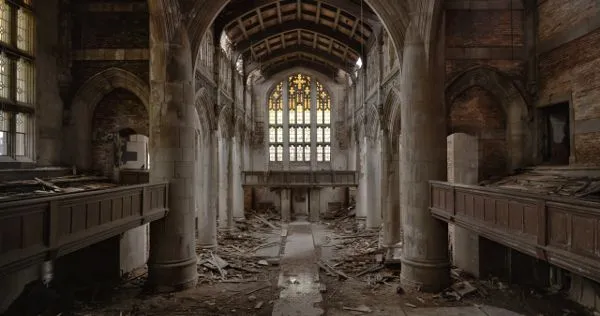Eye For Film >> Movies >> Homo Sapiens (2016) Film Review
Homo Sapiens
Reviewed by: Jennie Kermode

When we are gone, and Earth abides, how will it remember us?
Nikolaus Geyrhalter's haunting film opens with the sound of falling water, great gouts of rain pouring through broken roofs, tumbling across fallen columns, landing hard on wood and stone and concrete. We see it rippling over a battered mosaic. There lie the only human figures we will see in the entire film. There are no corpses, no bones. As the rain recedes, birdsong comes to the fore, many-toned and cacophonous. Small creatures skitter across uneven floors, barely glimpsed. Occasionally, some animal sound will approximate a human utterance, and you will find yourself grasping at it, longing to hear the sound of a voice. Homo Sapiens aches with loneliness. By the end, the bark of a dog elicits a similar reaction. If it might be found, the dog, at least, might offer some form of companionship in what has become an alien place.
Moving through it, pausing for take in a series of beautifully framed static vistas, you might be the last surviving human, an alien visitor, or a member of some species that has risen up in humankind's absence and is trying to make sense of what they left behind. A church retains some of its beauty, wan sunlight filtered through stained glass. A room fulling of metal lockers is inscrutable. Were they nesting sites; were they meant to be climbed on? Nobody is using them now. In other places, plants have taken over, intertwining themselves with exposed beams and winding around empty window frames. There is a marvellous greenness to these spaces, a sense that they are bursting with life. Elsewhere, there is only dust.
Devoid of dialogue though it my be, this feels like science fiction, like the reclaimed London John Wyndham posited in Day Of The Triffids in 1951. There are hints of The Quiet Earth, though this is a world gone further into ruin - or, perhaps, in the process of recovery after a cancer has been cut out. A shot within the interior of a church recalls the home of Peter Ustinov's character in Logan's Run. We see the concrete bunkers of JG Ballard's Terminal Beach. What happened here? Where did all the people go? This question might be asked as much of the settings as of the story they create. Homo Sapiens is laden with mystery; the more that it becomes clear that the search for answers is futile, the more compelling that search becomes, a sense of desperation setting in.
One might have thought that Earth would be quiet without us; instead, it is furiously loud. The wind, the birds, the waves, the wind. They sound triumphant now, and unconcerned with the observer. No longer cowed by human civilisation, they crowd the imagination. The effect is devastating. The journey becomes more frantic. No more the urban streets, the factories and supermarkets, the railway lines. We press on into wilder places. The further we go, the less hospitable the landscape becomes. We are reminded how little shelter Earth afforded us until we reinvented it. Now there is nowhere for us to return to.
With static shots, with a simple assembly of moments in time, Geyrhalter has created one of the most powerful cinematic wake up calls since Charlton Heston stood and cried out at the Statue of Liberty. Here, there are not even apes.
Reviewed on: 16 Dec 2016















